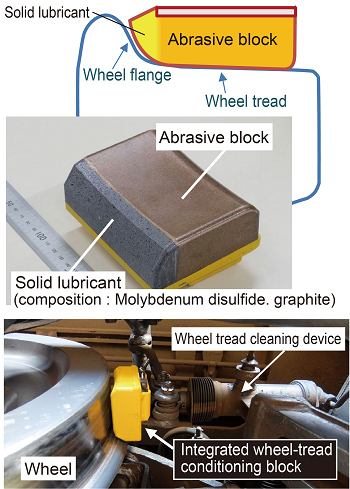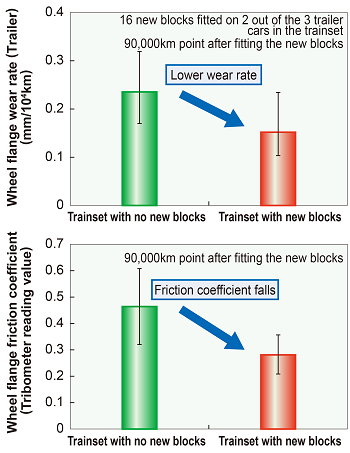13. Wheel flange-wear reducing wheel-tread friction block
Wheel flange wear progresses through flange-rail contact as trains run through curves, and a rise in the number of wheel re-profilings leads to increased costs, creating the need to control wheel-flange wear.
However, for noise and the derailment safety margin, a low friction coefficient is desirable.
To overcome this problem, flange lubricant is required. Greasing methods do exist, however, they can lead to wheel slipping and transfer of grease to the rail, and a work adjusting lubricant position is required, making these methods sometimes difficult to apply.
A new wheel-tread friction block was therefore developed (hereinafter, ‘integrated wheel-tread conditioning block’), combining lubrication of the flange and wheel tread adhesion improvement.
The new integrated wheel-tread conditioning block consists of wheel-tread abrasive material which is in contact with the wheel-tread, a built-in solid lubricant component in contact with the wheel flange, and can be installed in existing wheel-tread cleaning devices without modification (Fig.1). The wheel-tread conditioning block is molded as a single piece, and the block as a whole including boundaries between the solid lubricant and the tread abrasive material meet the same strength criteria as existing tread abrasive blocks.
Furthermore, the composition of the tread abrasive material in the new block is the same as the tried-and-tested material used in existing tread abrasive blocks.
The new blocks move vertically by the action of the wheel-tread cleaning device, and therefore no adjustment is required for different wheel diameters.
In addition, the wear rate of the integrated wheel-tread conditioning block is identical to that of the tread abrasive blocks, so no additional serviceable life management is required.
Introducing the new integrated wheel-tread conditioning block on a pendulum express train, on which existing greasing methods cannot be used, confirmed that wheel-flange wear was approximately 40% lower than without the integrated conditioning block.
It was also confirmed that the friction coefficient on the flange was lower (Fig 2).
Other Contents
- 12. Method for monitoring state of driving devices using vibration analysis and machine learning
- 13. Wheel flange-wear reducing wheel-tread friction block
- 14. High-strength bolted friction joints for existing weathering steel bridges
- 15. Bridge pier stability monitoring method using microtremor data
- 16. Low-cost continuous welded rail track structure suitable for regional railways
- 17. Track stiffness inspection method using portable track stiffness measuring device (RFWD)
- 18. Device to determine fouling of structural clearance gauge using on-board 3D laser scanner
- 12. Method for monitoring state of driving devices using vibration analysis and machine learning
- 13. Wheel flange-wear reducing wheel-tread friction block
- 14. High-strength bolted friction joints for existing weathering steel bridges
- 15. Bridge pier stability monitoring method using microtremor data
- 16. Low-cost continuous welded rail track structure suitable for regional railways
- 17. Track stiffness inspection method using portable track stiffness measuring device (RFWD)
- 18. Device to determine fouling of structural clearance gauge using on-board 3D laser scanner


